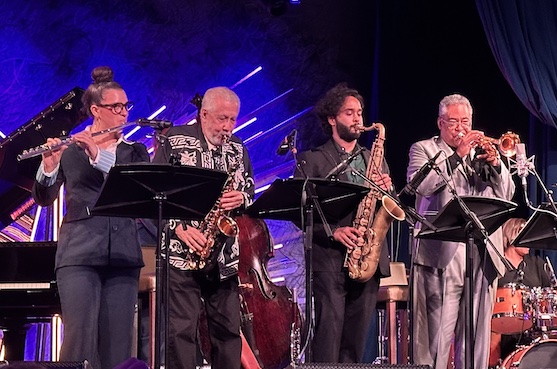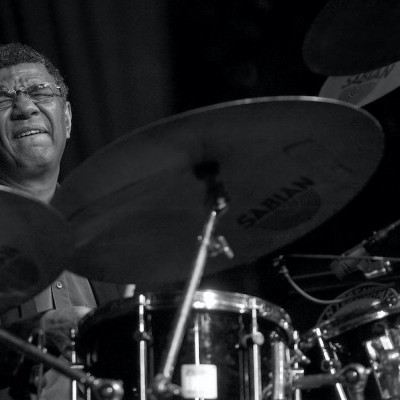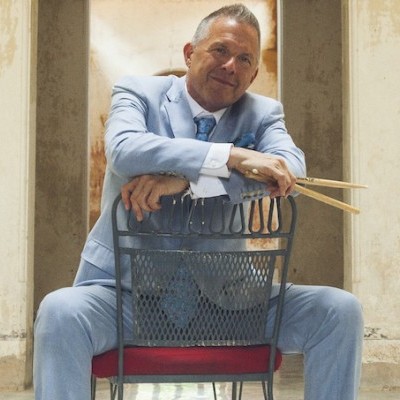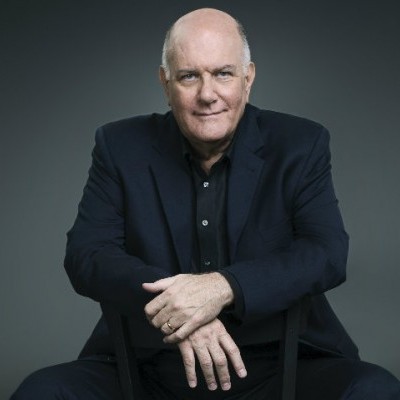Oct 28, 2025 10:47 AM
In Memoriam: Jack DeJohnette, 1942–2025
Jack DeJohnette, a bold and resourceful drummer and NEA Jazz Master who forged a unique vocabulary on the kit over his…

Elena Pinderhughes (left), Paquito D’Rivera, Birsa Chatterjee, Jon Faddis and Terri Lyne Carrington at the James Moody Centennial Celebration.
(Photo: Danny Kapilian)In the spring and summer of 2000, while reporting a DownBeat profile framed around James Moody’s 75th birthday concert with the Jazz at Lincoln Center Orchestra, I asked him to explain how he made the tenor, alto and soprano saxophones, and flute, each sound like his primary instrument.
“I need to practice them,” Moody responded crisply. “You play one horn because you like its sound. Then you play the other horn because you like its sound and you want to play certain things on it. But then you play the other horn and you like its sound and you want to play certain things on it. Finally, you want to play everything on everything. So you start trying to do that, and when you look, it’s time to go to bed. Then you get up and try something else; you look, and it’s time to go to a gig.”
Smiling broadly, Moody looked across the room at Linda Moody, his wife since 1989. “If I had $40 million, I’d give a concert every now and then, but I would be practicing in school every day,” he said. “My wife would be sitting, with somebody just fanning her, bringing her whatever she wanted.”
Linda Moody laughed. “Sitting down?” She laughed some more. “Oh, you’re so cute.”
This loving, slightly surreal exchange crossed my mind once or twice on May 27 during the James Moody Centennial Celebration, organized by Linda Moody as her latest gift to her spouse after his transition in 2010, in a packed Sony Hall in midtown Manhattan. Renee Rosnes, Moody’s first-call pianist from 1989 until he stopped playing in 2009, selected the 12-tune program, contributed several striking arrangements and ran the day-before rehearsal and day-of soundcheck. Under her surefooted guidance, the show, in its totality, embodied Moody’s artistic spirit, consummate professionalism, instrumental derring-do, communicative intent, “everything must change” multi-generational perspective, educational focus and embrace of the various cultural streams that guided him — and his self-described “musical father,” Dizzy Gillespie — in their musical expression. Her co-MD, Christian McBride, emceed throughout with unfailing charm, erudition, eloquence and efficiency; he also played bass on eight numbers, swinging mightily and tossing off several “how did he do that?” solos.
After Linda Moody’s opening remarks, McBride introduced trumpeters Jon Faddis and Randy Brecker, alto saxophonist-clarinetist Paquito D’Rivera and drummer Terri Lyne Carrington, all long-time Moody associates, along with 30-ish flutist Elena Pinderhughes and 20-something tenor saxophonist Birsa Chatterjee (winner of the James Moody Jazz Scholarship in 2015). Propelled by Carrington’s crisply spang-a-langing ride cymbal and fluid patterns, each musician displayed considerable bebop savoir faire, projecting fresh ideas, shapes and colors in their solos and exchanges on Charlie Parker’s “Au Privave” (which Moody recorded on the 1966 Milestone album Moody And The Brass Figures) and on Gillespie’s “A Night In Tunisia,” which Moody played on a nightly basis during his numerous sojourns with Gillespie between 1946 and the late 1980s.
For Moody’s “Darben, The Redd Foxx,” most famously recorded by his septet in 1959, Rosnes transcribed and scored a portion of his flute solo for the five horns. As lead voice, Pinderhughes’ enormous sound, gorgeous intonation, precise articulation and fluid time-feel stamped the unisons and — responding to Carrington’s percolating backbeats — her elegantly constructed improvisation. Equally compelling were the declamations by Brecker, Chatterjee and D’Rivera, who interpolated a Lester Young quote in his ebullient alto solo. Later, on “Cherokee,” Pinderhughes followed Chatterjee’s brashly textured melodic statement by signifying on Moody’s fleet solo from Brass Figures, constructing long, spiraling lines that felt like instant composition, inspiring Rosnes to occupy Bud Powell territory for several choruses.
Later, as Carrington’s evocative danzon-ish beats maneuvered the band from Rosnes’ “Con Alma” contrafact, “Dizzy Spells,” into Gillespie’s iconic bolero, D’Rivera — a Gillespie associate since arriving in the United States in the early 1980s — spun out clarinet variations reflecting his long involvement with the title’s soulful message.
Carrington’s dynamically varied onomatopoeic shuffle propelled Rosnes’ surging piano solo and Todd Coolman’s several well-wrought bass choruses on Moody’s oft-covered “Last Train From Overbrook,” named for the facility that he entered for five months in 1958 to recuperate from alcohol dependence, enabling him to reboot sufficiently to begin the systematic studies that fueled him for the rest of his life.
Coolman and Adam Nussbaum, Moody’s longtime bassist and drummer, expertly guided the flow on Roberta Gambarini’s heartfelt reading of her lyrics to Claudio Roditi’s “Linda’s Moody,” a bolero that served as a vehicle for Moody’s tender tenor on D’Rivera’s 1992 album Who’s Smoking?!, which included their United Nations Orchestra bandmate Danilo Pérez and Al Foster.
The Coolman-Nussbaum team had joined the proceedings with rising-star singer Tyreek McDole (winner of the 2023 Sarah Vaughan International Jazz Vocal Competition, held at the TD James Moody Jazz Festival in Newark, New Jersey, Moody’s home town), who applied his resonant baritone to Moody’s witty, dyspeptic vocalese lyric “Benny’s From Heaven” set to his early 1950s solo on “Pennies From Heaven.” McDole nailed the more-difficult-to-execute-than-they-seem intervals from the source solo for the lyric, and paid attention to Moody’s deliberate nightly misstep of “that little bast ...” for the tune’s namesake in place of “tell me where that little Benny comes from.” Toward the evening’s end, McDole and Gambarini enthusiastically addressed the male and female roles of the anthemic “Moody’s Mood For Love,” penned by vocalese giant Eddie Jefferson (Moody’s band singer and road manager for much of the 1950s) in response to Moody’s alto sax improvisation on a 1949 date in Sweden. It became a hit for King Pleasure in 1952, the year Moody returned to the U.S. from a three-year sojourn in Paris. Moody soon incorporated it into his repertoire, and sang it with full commitment at almost every performance for the next 57 years.
The full ensemble took a bebop workout on the finale, Gillespie’s not-for-neophytes scat number “Oop-Pop-A-Dah.” Madeline Peyroux, who’d earlier applied her conversational phrasing to “It Might As Well Be Spring” and “The Mood That I’m In” with Rosnes, McBride and Carrington, joined Gambarini, McDole and the horns on a series of exchanges. Carrington responded to each salvo with creative beats and timbres, before launching a solo that addressed Max Roach’s language in her own dialect.
“Moody’s music and his life will always be celebrated,” Rosnes said the day after the concert. “He’s a giant player, and a key founding proponent of the bebop genre, but aside from that, he’s such a loved man. He lives in my heart. It’s almost like he’s still here, in a way, because I feel his spirit so deeply in my soul and will do, I’m sure, for the rest of my life.” DB

Jack DeJohnette boasted a musical resume that was as long as it was fearsome.
Oct 28, 2025 10:47 AM
Jack DeJohnette, a bold and resourceful drummer and NEA Jazz Master who forged a unique vocabulary on the kit over his…

Always a sharp dresser, Farnsworth wears a pocket square given to him by trumpeter Art Farmer. “You need to look good if you want to hang around me,” Farmer told him.
Sep 23, 2025 11:12 AM
When he was 12 years old, the hard-swinging veteran drummer Joe Farnsworth had a fateful encounter with his idol Max…

D’Angelo achieved commercial and critical success experimenting with a fusion of jazz, funk, soul, R&B and hip-hop.
Oct 14, 2025 1:47 PM
D’Angelo, a Grammy-winning R&B and neo-soul singer, guitarist and pianist who exerted a profound influence on 21st…

Kandace Springs channeled Shirley Horn’s deliberate phrasing and sublime self-accompaniment during her set at this year’s Pittsburgh International Jazz Festival.
Sep 30, 2025 12:28 PM
Janis Burley, the Pittsburgh International Jazz Festival’s founder and artistic director, did not, as might be…

Jim McNeely’s singular body of work had a profound and lasting influence on many of today’s top jazz composers in the U.S. and in Europe.
Oct 7, 2025 3:40 PM
Pianist Jim McNeely, one of the most distinguished large ensemble jazz composers of his generation, died Sept. 26 at…